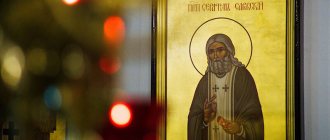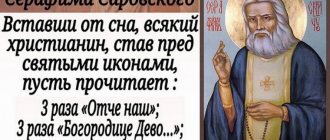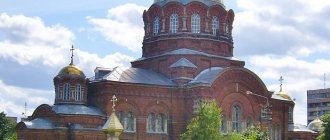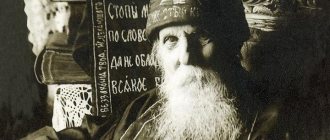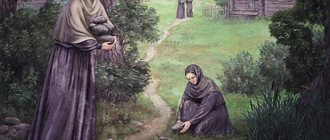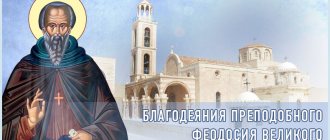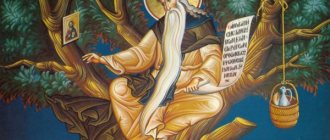July 30, 1754 – January 14, 1833 (78 years old)
4
Average rating: 4
Total ratings received: 275.
Seraphim of Sarov (1754–1833) - hieromonk of the Sarov Monastery, founder of the Diveyevo convent. Glorified by the Russian Church in 1903 as a saint. Seraphim of Sarov, whose biography serves as an example of sincere faith and love for others, is one of the most revered saints in Rus'. A report on the life and work of the hieromonk will be especially interesting for children and 5th grade students.
The childhood and youth of St. Seraphim of Sarov
The small homeland of Seraphim of Sarov was the city of Kursk. The monk came from a well-known, quite wealthy merchant family. Seraphim's father, Isidor Moshnin, was a pious and devout man. By the nature of his earthly activity, he owned brick factories, was engaged in trade, and took out contracts for the construction of houses and churches. Seraphim's mother, Christian Agafia Fotievna, was not inferior to him in virtue, but was especially distinguished by her mercy and attention to the poor.
From the marriage of Isidor and Agafia Moshnin, three children were born: Paraskeva, Alexey and Prokhor, the future father Seraphim. Seraphim was born in 1754, on the night of July 19-20. It is believed that the name Prokhor was given to him at Baptism in honor of one of the seven deacons appointed by the apostles, whose feast day is celebrated on July 28.
Seraphim's father, Isidore, died quite early, and the entire burden of responsibility for maintaining and raising children fell on the shoulders of the widow. She took upon herself the burden of managing her fortune and affairs, upon completion of the construction of the temple in the name of St. Sergius, begun by her husband.
One day, while monitoring the progress of construction and inspecting the bell tower, Agathia climbed to the top, and Prokhor, who accompanied her, approached the edge, hung over the railing, could not resist and fell from the height. The mother ran downstairs in horror, but when she appeared before her son, she found him healthy and unharmed. This is how God showed His first miracle over the future lamp of the Russian land.
At the age of ten, Prokhor suffered from a serious illness. It would seem that everything is moving towards a disappointing end: some did not even count on his recovery. But then the Heavenly Queen appeared to Prokhor, promising healing. And a little later, when the Root Icon of the Mother of God was being carried around the city, and when, due to a sudden downpour, it was carried through the Moshnins’ courtyard to shorten the path, the mother, having found her bearings, quickly took her child, carried him into the courtyard and brought him to the miraculous image Soon the child began to recover, began to grow stronger and recovered. So God showed a second miracle in relation to Seraphim.
After this, Prokhor took up his studies with even greater diligence, spent a lot of time reading, and learned to write.
One day the Providence of God brought him away from Christ for the sake of the fool. They say that having met Agathia with his two sons on the street, he, looking at Prokhor, announced his future glory as a saint of God. Subsequently, communicating with the holy fool, Prokhor absorbed a lot of good and kindness from him.
At that time, he often visited the temple and prayed a lot. Meanwhile, he did not shy away from the role of his mother’s assistant in economic and trading matters, and performed the proper work. However, the more he grew in spiritual age, the more he realized how difficult it was to combine solitude, love and service to God with commercial profits and the worries of the world.
Childhood
The future hieromonk was born on July 30, 1759 in Kursk and became the second son in the pious Moshnin family. His father Isidore was a prominent merchant and owner of several brick factories. Like his wife Agathia, he was known as a kind and conscientious person, helping the poor and orphans. In 1752, Isidore began the construction of the Church of St. Sergius. However, he did not have time to complete the construction; he died in 1762, instructing his wife to continue this godly work before his death. The widow fulfilled her husband's last wishes and personally supervised all the work.
Seraphim of Sarovsky in childhood
The youngest son was distinguished by deep faith, intelligence, an inquisitive mind and a good memory. He learned to read and write with interest and fell in love with reading spiritual literature. God wanted to reveal his purpose from childhood. When, at the age of 7, a boy was inspecting a temple under construction with his mother and fell from a high bell tower, to the great joy and surprise of his loved ones he did not crash and remained absolutely unharmed.
God's protection over him manifested itself later. At the age of 10, he became seriously ill, causing his family to fear for his life. But the Blessed Virgin appeared to him in a dream and promised that he would be healed. And so it happened: he was placed next to the Kursk Icon of Our Lady of the Sign, and he quickly began to recover.
On the way to monastic life
Prokhor dreamed more and more about monastic life. Knowing and understanding the religious aspirations of her son, remembering the miracles that happened to him, Agathia did not interfere with her son, and would rather let him go, entrusting him to the Providence of God, than keep him to herself with maternal tears and reproach. It is believed that Prokhor made the final decision in this regard in the seventeenth year of his life.
On the one hand, he was attracted by the Sarov monastery, where by that time many of his fellow countrymen labored. But on the other hand, he wanted to pray at the holy relics of Saints Anthony and Theodosius, get acquainted with the life of the Kiev-Pechersk monks, and receive instruction and blessings from the elders there. He went there on foot, along with five pilgrims. Before leaving, his mother blessed him with a copper cross, which he then did not part with, and which he wore on his chest throughout his earthly life.
Having reached Kyiv, the travelers found out that a seer, Dositheus, was working in the Kitaevskaya desert. Prokhor headed towards him. The elder, having seen the will of God, gave him a parting admonition, pointed out the need to constantly preserve the memory of God and call on the name of the Lord, and blessed him for asceticism in the Sarov desert.
After this, Prokhor returned home for a while to Kursk and lived there for several months. No matter how bitter it was for Agafya to part with her son again, she blessed him again, and he left again: to where he had long been with his heart.
After a long and difficult journey, he finally arrived at the monastery. This happened on November 20, 1778.
Feat of desert living
At the age of 39, the monk was elevated to the rank of hieromonk and was blessed to conduct the Divine Liturgy. When the abbot of the monastery departed to the Lord, Seraphim took upon himself the feat of living in the desert (the late Father Pachomius blessed the monk before his death). Having received another blessing from the new abbot, he retired into the deep forest.
But he did not completely abandon the monastery; every Saturday evening, before the start of the all-night vigil, he returned to the monastery and received the Holy Mysteries of Christ.
The exploits of Seraphim, which he performed in the Name of Christ, were severe:
- his prayer rule was carried out according to the Rule of the ancient desert dwellers;
- he constantly studied the Holy Gospel, the New Testament, diligently studied liturgical literature;
- the monk knew many chants by heart, and when he worked in the forest, he loved to hum them;
- he got food for himself, worked in the garden;
- He kept a strict fast, ate only once a day, and went hungry on fasting days of the week.
His meager diet during the first three years of hermitage consisted of herbs. Occasionally he was visited by the same hermits.
The rumor about the solitary life of the priest spread beyond the monastery and monks and laymen began to visit him often. Each person needed wise advice, answers to questions and blessings for their work. Soon Seraphim forbade women from visiting his cell, and then everyone else, because in another vision the monk saw that the Lord desired the monk’s complete silence.
The saint’s social circle narrowed; now only wild animals and birds could visit him. Seraphim loved to feed wild bears with bread, which was delivered to him from the monastery bakery.
Icon of Seraphim of Sarov
Temptations of the devil
The monk's lofty exploits aroused the disapproval of the devil. He decided to frighten the saint so that he would remain silent. The monk did not succumb to the attacks of dark forces, but Satan stubbornly continued the temptation. But Seraphim, in order to repel the onslaught of the enemy, took on the feat of pillar-bearing for 1000 days.
But disgraced by the saint’s faith, the devil decided to kill the saint and sent robbers to him, who began to demand money from him. Naturally, he had no money, for which the robbers brutally beat the monk and broke his head with an ax. The saint lay in a lifeless state until the morning, and when he woke up, with the last of his strength he made his way to the monastery. The brethren were horrified by the sight of the wounded ascetic. For eight days, the monastery doctors pulled Seraphim “from the other world,” because the wounds he received were incompatible with life.
But the healing did not come from doctors. The Queen of Heaven appeared to him in a dream and, touching his wounded forehead, gave him health. But the monk’s back remained hunched, so he had to walk leaning on his staff.
The monk spent about six months in the monastery, and having gained strength, he returned to his forest cell. He spent three years in silence. Seraphim was asked by the abbot and the brethren of the monastery: to attend services and receive communion, or to return to the monastery. Seraphim chose the second because, due to his injury and advanced years, it was difficult for him to walk from the forest, in which he accomplished the feat of living in the desert for 15 years, to the monastery.
The end of the earthly journey
Returning, he added a shutter to the feat of silence. The monk did not leave his cell and did not receive anyone.
For his labors, he was honored by the Lord with the gift of working miracles and was assigned to serve people in the feat of old age. The Mother of God herself appeared in a dream to Seraphim and commanded him to come out of seclusion in order to receive petitioners asking for guidance, consolation, and healing.
Now the door of the elder’s cell was open to everyone! The miracle worker contemplated human hearts, healed parishioners with prayer, and consoled them with kind words.
In the last years of his life, Seraphim took special care of the Diveyevo monastery, which was his brainchild. He was a kind father to the sisters of the monastery, looked after the monastery, and the sisters turned to the elder in all difficulties.
A year before his death, Father Seraphim became very weak and made a coffin for himself. He showed the monks the place where his body should be buried. On January 1, 1833, the elder took communion for the last time, after which he blessed the brethren and gave good wishes to each monk, and the next day he reposed in the Lord.
His body was found lifeless before the Face of the Mother of God.
During illness in adolescence
The beginning of the monastic exploits of St. Seraphim of Sarov
The abbot of the monastery, Elder Pachomius, entrusted the spiritual guardianship of Prokhor to the wise and experienced ascetic, treasurer, Elder Joseph. Initially, Prokhor was assigned the obedience of a cell attendant. As the stay continued, one obedience was replaced by another. Prokhor worked meekly and diligently both in the bakery, in the prosphora, and in the carpentry; He served as an alarm clock, then as a sexton, and together with his brothers he prepared firewood.
Prokhor prayed a lot, read, and observed abstinence. Having in mind examples from the lives of the great desert dwellers and gravitating toward solitude, he asked for a blessing to retire to the forest during hours free from obedience and duties. There he built a small hut for himself and devoted himself to contemplation and prayer in it.
About 2 years after entering the monastery, Prokhor fell ill and became swollen. This illness, presumably dropsy, lasted for almost three years. Prokhor's illness was so serious that they began to fear for his life. But by the grace of God he was healed: one day, after communion of the Holy Mysteries of Christ, the Mother of God appeared to him, accompanied by the apostles Peter and John, and after Her miraculous intervention the disease receded.
Subsequently, at the site of this miracle, they began to build a hospital building, and with it a church. They claim that the site of the appearance of the Mother of God was on the altar of the temple being built. A financial levy was authorized for construction. Prokhor willingly accepted the collector’s obedience. Walking around different places for this purpose, he reached Kursk, where he met with his relatives. His brother, Alexey, made a significant contribution to the construction. After this, Prokhor returned to the monastery. Being a skilled carpenter, he personally made a throne for the church.
On August 13, 1786, Abbot Pachomius tonsured Prokhor to the rank of monk. From that time on, Prokhor adopted a new name - Seraphim. And a little later, on October 27, 1786, the Bishop of Vladimir and Murom, His Eminence Victor, Seraphim was ordained to the rank of hierodeacon. They claim that during the period of his diaconal service he more than once contemplated angelic powers at the Divine Liturgy.
On September 2, 1793, Bishop Theophilus ordained Seraphim as hieromonk. About a year later, Father Pachomius died. Before this, he entrusted Father Seraphim with the care of the Diveyevo sisters, which, in turn, was asked of him before his death by their abbess, Elder Agafya Melgunova.
From that time on, Father Seraphim, prepared by Providence for life in solitude, asked the new abbot, Father Isaiah, for a blessing to live in the desert. This happened 16 years after Prokhor’s arrival at the monastery. In addition to internal reasons, the reverend’s physical illness contributed to this decision. From incessant pastoral labors and kneeling cell prayers, Father Seraphim’s feet became covered with wounds and swollen; It was difficult for him to bear monastic obedience.
Heritage
Popular veneration of the saint was observed during his lifetime. After his death, a large number of people continued to come to his burial place with grief, requests and gratitude. However, the canonization of Seraphim of Sarov took place only at the firm command of Nicholas II in 1903, in the presence of members of the royal family and many people (about 150 thousand).
Icon of Seraphim of Sarov
The emperor insisted on canonization because, being a deeply religious man, he firmly believed that it was thanks to the mantle of the Sarov prayer book that the seven-year-old daughter of Alexander II recovered. He prayed to him that Empress Alexandra Feodorovna would have a son after four daughters (which actually happened in 1904).
After the Revolution, in 1920, the relics of Sarovsky in Diveevo were opened and two years later they were transferred for storage to the Donskoy Monastery, which was turned into the Museum of Religious Art. For 57 years, the elder’s relics lay in the attic among other religious objects. In 1990, in the Kazan Cathedral of the Northern capital, in the Museum’s storerooms, remains were discovered that were not included in the inventory. It was established that these were the relics of Seraphim of Sarov. They were installed for worship in the Moscow Epiphany Church, and then transported to the burial place in the Seraphim-Diveevsky Convent in the name of the Holy Trinity.
Prophet Seraphim of Sarov
To this day, believers venerate Seraphim of Sarov and pray to him for:
- choosing the right destination;
- spiritual and physical healing;
- perseverance in the face of life's adversities;
- creating strong marriages and harmony in families;
- pacification, getting rid of passions, alcoholism, drug addiction;
- prosperity and success in all matters.
The hermit life of St. Seraphim
The Monk Seraphim settled approximately five miles from the monastery, on the banks of the Sarovka River, in a wooden cell located on an elevated place in a deep, deserted forest.
Living in solitude, the saint prayed a lot, performed divine services, read, and cultivated a small garden. He wore only wretched clothes, and on his shoulders was a bag with the Holy Gospel. On the eves of Sundays and holidays, he returned to the monastery, confessed, received communion, and talked with those who needed to communicate with him.
Despite the certain inaccessibility of Seraphim’s home, people came to him there too: some for consolation, some for advice and blessing. Considering it inconvenient for himself to communicate with female persons, and at the same time believing that refusal to edify could violate the Divine will, Seraphim turned to the Most Holy Theotokos and the Lord with a prayer to give him a special sign. According to legend, in response to the saint’s prayer, after a short period of time, the path leading to the cell was littered with branches of mighty trees. Seeing this, Father Seraphim fell before God and gave Him thanks and praise.
It is reported that, raising a battle against the ascetic Seraphim, the devil sought to instill fear in him: either he showed him the howl of a wild beast, then a large crowd, or a coffin with a dead man, then he lifted him into the air and threw him down with force, from which his Guardian Angel saved him. .
And one day, on September 12, 1804, when the monk was preparing firewood for the household, three villains approached him and demanded money from him, believing that Seraphim was keeping material donations. The monk met the danger with deep Christian humility: he did not resist the robbers, although he was holding an ax in his hands. When he lowered the ax, one of the robbers picked it up and hit the saint on the head with its butt. After this, the uninvited guests began to beat the monk, despite the fact that he lost consciousness from the blow. Then they dragged him to the house, tied him up and searched him, they turned over the whole cell, but no wealth was found. Then they were overcome with terror and ran away.
Having come to his senses, Father Seraphim independently freed himself from his shackles, gave praise to God and, trusting in His mercy, prayed for the forgiveness of the offenders. Somehow, overcoming himself, he made it to the monastery. For eight days Seraphim suffered terribly, did not eat, could not even sleep. When doctors called from Arzamas arrived, they discovered: the saint’s head was broken, his ribs were broken, his body was wounded. By the end of the examination, Father Seraphim fell into oblivion and was honored with another appearance of the Mother of God. She came with the apostles: Peter and John. Looking at Seraphim, the Most Holy One turned to the apostles with the words: “This is from our generation.” Seraphim was filled with extreme joy, and in the evening he got out of bed, asked for food and refreshed himself. Gradually his condition improved. However, the traces of that brutal crime, in particular the stoop, were imprinted for life. From now on, when Saint Seraphim walked, he supported himself on a hoe or an ax.
Five months later, Seraphim, having asked for a blessing, returned to solitude. And soon the robbers were caught. They turned out to be serfs. The indignation of the residents knew no bounds. They wanted to put the villains on trial, but Father Seraphim begged Father Isaiah and their landowner, Tatishchev, to have mercy on them, which was done. Meanwhile, having left the human court, they did not leave the Court of God's Truth. After their houses burned down, they themselves came to the monk, begging him for forgiveness and prayers for them.
Among other signs that occurred with the participation of Saint Seraphim and indicating the special favor of God towards him, they name his relationship with wild animals, which he fed from his poor table. Among others, the bear was a frequent guest of the reverend father. According to an eyewitness, he once watched Saint Seraphim, sitting on a log, feed a bear with crackers, after which the animal, having feasted on it, turned around and went into the forest.
When in 1806 Father Isaiah became weak and resigned from leadership, the brethren wanted to elect Father Seraphim in his place. This was already the second offer to the monk to take on the role of rector (the first came even earlier, when the position of archimandrite in Altyr became vacant). But the monk rejected him too.
After the death of Isaiah in 1807, Father Seraphim chose for himself an even more severe ascetic feat - silence. The saint remained there for three years. He no longer received visitors, and if he suddenly met someone in the forest, he fell on his face and did not raise his face until he left. The monk visited his monastery less and less, sometimes he did not appear there even on holidays.
Halfway between the monastery and the cell lay a huge granite boulder. For a thousand days, Father Seraphim came to this stone every night and, standing on his feet or on his knees, raising his hands to Heaven, prayed. Another stone was located in the cell, where he prayed during the day, interrupting only to eat food and take the necessary rest.
Life (short) of Elder Seraphim with many icons Historical background.
Seraphim of Sarov (in the world Prokhor Isidorovich Moshnin), venerable, desert-dwelling elder and recluse. One of the most revered saints in the Russian Orthodox Church.
Born in the city of Kursk in 1754
year.
In 1778
he entered the novices of the Sarov Hermitage.
Having completed all the degrees of monastic art in 8 years, he was tonsured a monk and named Seraphim; in 1793
he was ordained hieromonk. Voluntarily retiring into the desert, he spends all his time in strict fasting, in labor and in prayer. Then he imposed a three-year silence on himself, and later seclusion. Upon leaving the retreat, he began to receive the suffering, console and heal them. On some holidays, several thousand people came to see him. Seraphim of Sarov made special efforts to establish and expand the Diveyevo women's community, forming a special Seraphim-Diveyevo community. His works extended to the organization of the Ardatov women's monastery and the Zelenogorsk community.
Died January 2 (15), 1833
of the year.
July 19 (August 1, New Year) 1903
The discovery of his relics followed. He was canonized 70 years after his death. The canonization ceremony took place in Sarov with a large crowd of people and in the presence of Tsar Nicholas II. His relics were opened for veneration in the Sarov desert.
In the 20s
years, the monastery was closed, and the relics were taken to Ardatov, where they disappeared.
Only in 1991
they were discovered in the funds of the State Museum of the History of Religion, located in the Kazan Cathedral in St. Petersburg. In the summer of the same year, they were taken in a religious procession to the Nizhny Novgorod land to the Seraphim-Diveevsky Monastery.
IN 2006
monastic life was resumed in the Sarov Hermitage.
Life of the Holy Venerable Elder Seraphim of Sarov
Venerable Seraphim of Sarov, a great ascetic of the Russian Church, was born on July 19, 1754.
The saint's parents, Isidore and Agafia Moshnin, were residents of Kursk. Isidore was a merchant and took out contracts for the construction of buildings, and at the end of his life he began the construction of a cathedral in Kursk, but died before the completion of the work. The youngest son Prokhor remained in the care of his mother, who raised a deep faith in her son. After the death of her husband, Agafia Moshnina, who continued the construction of the cathedral, once took Prokhor with her there, who, having stumbled, fell from the bell tower. The Lord saved the life of the future lamp of the Church: the frightened mother, going downstairs, found her son unharmed. Young Prokhor, having an excellent memory, soon learned to read and write. Since childhood, he loved to attend church services and read the Holy Scriptures and Lives of Saints to his peers, but most of all he loved to pray or read the Holy Gospel in solitude. One day Prokhor became seriously ill and his life was in danger. In a dream, the boy saw the Mother of God, who promised to visit and heal him. Soon a religious procession with the icon of the Sign of the Most Holy Theotokos passed through the courtyard of the Moshnin estate; his mother carried Prokhor out in her arms, and he venerated the holy icon, after which he began to quickly recover. Even in his youth, Prokhor made the decision to completely devote his life to God and enter a monastery. The pious mother did not interfere with this and blessed him on the monastic path with a crucifix, which the monk wore on his chest all his life. Prokhor and the pilgrims set off on foot from Kursk to Kyiv to worship the Pechersk saints. The schemamonk elder Dosifei, whom Prokhor visited, blessed him to go to the Sarov hermitage and save himself there. Returning briefly to his parents' house, Prokhor said goodbye to his mother and relatives forever. On November 20, 1778, he came to Sarov, where the wise old man, Father Pachomius, was then rector. He kindly received the young man and appointed Elder Joseph as his confessor. Under his leadership, Prokhor underwent many obediences in the monastery: he was the elder’s cell attendant, worked in the bakery, prosphora and carpentry, carried out the duties of a sexton, and performed everything with zeal and zeal, serving as if the Lord Himself. By constant work he protected himself from boredom - this, as he later said, “the most dangerous temptation for new monks, which is cured by prayer, abstinence from idle talk, feasible handicraft, reading the Word of God and patience, because it is born from cowardice, carelessness and idle talk.” .
Already in these years, Prokhor, following the example of other monks who retired into the forest to pray, asked the elder’s blessing to also go into the forest in his free time, where he prayed the Jesus Prayer in complete solitude. Two years later, novice Prokhor fell ill with dropsy, his body became swollen, and he experienced severe suffering. The mentor, Father Joseph, and other elders who loved Prokhor looked after him. The illness lasted about three years, and not once did anyone hear a word of grumbling from him. The elders, fearing for the life of the patient, wanted to call a doctor to him, but Prokhor asked not to do this, telling Father Pachomius: “I have given myself, Holy Father, to the True Doctor of souls and bodies - our Lord Jesus Christ and His Most Pure Mother...”, and wanted to be given Holy Communion. Then Prokhor had a vision: the Mother of God appeared in an indescribable light, accompanied by the holy apostles Peter and John the Theologian. Pointing her hand at the sick man, the Most Holy Virgin said to John: “This one is from our generation.” Then she touched the patient’s side with the staff, and immediately the liquid that filled the body began to flow out through the hole formed, and he quickly recovered. Soon, on the site of the appearance of the Mother of God, a hospital church was built, one of the chapels of which was consecrated in the name of the Monks Zosima and Savvaty of Solovetsky. The altar for the chapel was built by the Monk Seraphim with his own hands from cypress wood and he always received the Holy Mysteries in this church.
After spending eight years as a novice in the Sarov monastery, Prokhor took monastic vows with the name Seraphim, which so well expressed his fiery love for the Lord and desire to serve Him zealously. A year later, Seraphim was ordained to the rank of hierodeacon. Burning in spirit, he served in the temple every day, constantly praying even after the service. The Lord vouchsafed the monk visions of grace during church services: he repeatedly saw holy Angels serving with the brethren. The monk was granted a special vision of grace during the Divine Liturgy on Maundy Thursday, which was performed by the rector, Father Pachomius, and Elder Joseph. When, after the troparions, the monk said, “Lord, save the pious,” and, standing at the royal doors, pointed his orar at those praying with the exclamation “and forever and ever,” suddenly a bright ray overshadowed him. Raising his eyes, the Monk Seraphim saw the Lord Jesus Christ walking through the air from the western doors of the temple, surrounded by the Heavenly Ethereal Forces. Having reached the pulpit, the Lord blessed all those praying and entered the local image to the right of the royal doors. The Monk Seraphim, looking in spiritual delight at the wondrous phenomenon, could not utter a word or leave his place. He was led arm in arm into the altar, where he stood for another three hours, his face changing from the great grace that illuminated him. After the vision, the monk intensified his exploits: during the day he worked in the monastery, and spent his nights in prayer in a deserted forest cell.
In 1793, at the age of 39, St. Seraphim was ordained to the rank of hieromonk and continued serving in the church. After the death of the abbot, Father Pachomius, the Monk Seraphim, having his dying blessing for a new feat of desert living, also took the blessing from the new abbot - Father Isaiah - and went to a desert cell a few kilometers from the monastery, in a dense forest. Here he began to indulge in solitary prayers, coming to the monastery only on Saturday, before the all-night vigil, and returning to his cell after the liturgy, during which he received the Holy Mysteries. The monk spent his life in severe exploits. He carried out his cell prayer rule according to the rules of the ancient desert monasteries; I never parted with the Holy Gospel, reading the entire New Testament during the week, and also read patristic and liturgical books. The monk learned many church hymns by heart and sang them during his work hours in the forest. Near the cell he planted a vegetable garden and built a beekeeper. Earning food for himself, the monk kept a very strict fast, eating once a day, and on Wednesday and Friday he completely abstained from food. In the first week of Holy Pentecost, he did not take food until Saturday, when he received Holy Communion. The holy elder, in solitude, was sometimes so immersed in inner heartfelt prayer that he remained motionless for a long time, neither hearing nor seeing anything around him. The hermits who visited him from time to time - schemamonk Mark the Silent and hierodeacon Alexander, having caught the saint in such prayer, quietly withdrew with reverence, so as not to disturb his contemplation.
In the summer heat, the monk collected moss from the swamp to fertilize the garden; mosquitoes mercilessly stung him, but he complacently endured this suffering, saying: “Pasions are destroyed by suffering and sorrow, either voluntary or sent by Providence.” For about three years, the monk ate only one herb, snitis, which grew around his cell. In addition to the brethren, lay people began to come to him more and more often for advice and blessings. This violated his privacy. Having asked for the abbot’s blessing, the monk blocked women’s access to him, and then everyone else, having received a sign that the Lord approved of his idea of complete silence. Through the saint’s prayer, the road to his deserted cell was blocked by huge branches of centuries-old pine trees. Now only birds, which flocked in large numbers to the saint, and wild animals visited him. The monk fed the bear bread from his hands when bread was brought to him from the monastery.
Seeing the exploits of the Monk Seraphim, the enemy of the human race armed himself against him and, wanting to force the saint to leave silence, decided to frighten him, but the saint protected himself with prayer and the power of the Life-giving Cross. The devil brought “mental warfare” upon the saint—a persistent, prolonged temptation. To repel the onslaught of the enemy, the Monk Seraphim intensified his labors by taking upon himself the feat of stylite mongering. Every night he climbed a huge stone in the forest and prayed with raised hands, crying: “God, be merciful to me a sinner.” During the day, he prayed in his cell, also on a stone that he brought from the forest, leaving it only for a short rest and strengthening his body with meager food. The saint prayed like this for 1000 days and nights.
The devil, disgraced by the monk, planned to kill him and sent robbers. Approaching the saint, who was working in the garden, the robbers began to demand money from him. The monk at that time had an ax in his hands, he was physically strong and could have defended himself, but he did not want to do this, remembering the words of the Lord: “Those who take the sword will perish by the sword” (Matthew 26:52). The saint, lowering the ax to the ground, said: “Do what you need.” The robbers began to beat the monk, broke his head with a butt, broke several ribs, then, having tied him up, they wanted to throw him into the river, but first they searched his cell for money. Having destroyed everything in the cell and finding nothing in it except an icon and a few potatoes, they were ashamed of their crime and left. The monk, having regained consciousness, crawled to his cell and, suffering severely, lay there all night.
The next morning, with great difficulty, he reached the monastery. The brethren were horrified when they saw the wounded ascetic. The monk lay there for eight days, suffering from his wounds; Doctors were called to him, surprised that Seraphim remained alive after such beatings. But the monk did not receive healing from doctors: the Queen of Heaven appeared to him in a subtle dream with the apostles Peter and John. Touching the head of the monk, the Most Holy Virgin granted him healing.
After this incident, the Monk Seraphim had to spend about five months in the monastery, and then he again went to a desert cell. Remaining bent forever, the monk walked, leaning on a staff or an axe, but he forgave his offenders and asked them not to punish them. After the death of the rector, Father Isaiah, who had been his friend since the saint’s youth, he took upon himself the feat of silence, completely renouncing all worldly thoughts for the purest stand before God in unceasing prayer. If the saint met a person in the forest, he fell on his face and did not get up until the passerby moved away. The elder spent about three years in such silence, stopping even from visiting the monastery on Sundays.
The fruit of silence was for St. Seraphim the acquisition of peace of soul and joy in the Holy Spirit. The great ascetic subsequently spoke to one of the monks of the monastery: “...my joy, I pray to you, the banners have a peaceful spirit, and then thousands of souls will be saved around you.”
The new abbot, Father Nifont, and the elder brethren of the monastery suggested that Father Seraphim either continue to come to the monastery on Sundays to participate in divine services and receive communion at the monastery of the Holy Mysteries, or return to the monastery. The monk chose the latter, since it became difficult for him to walk from the desert to the monastery. In the spring of 1810, he returned to the monastery after 15 years in the desert. Without breaking his silence, he added seclusion to this feat and, without going anywhere or receiving anyone, he was constantly in prayer and contemplation of God. While in retreat, the Monk Seraphim acquired high spiritual purity and received from God the special grace-filled gifts of clairvoyance and miracle-working. Then the Lord appointed His chosen one to serve people in the highest monastic feat of eldership.
On November 25, 1825, the Mother of God, together with the two saints celebrated on this day, appeared in a dream vision to the elder and commanded him to come out of seclusion and receive weak human souls that required instruction, consolation, guidance and healing. Having been blessed by the abbot for a change in his lifestyle, the monk opened the doors of his cell to everyone.
The elder saw the hearts of people, and he, as a spiritual doctor, healed mental and physical illnesses with prayer to God and a word of grace. Those who came to St. Seraphim felt his great love and listened with tenderness to the affectionate words with which he addressed people: “my joy, my treasure.” The elder began to visit his desert cell and the spring called Bogoslovsky, near which they built a small cell for him. When leaving his cell, the elder always carried a knapsack with stones over his shoulders. When asked why he was doing this, the saint humbly answered: “I torment him who torments me.”
In the last period of his earthly life, the Monk Seraphim took special care of his beloved brainchild - the Diveyevo women's monastery. While still in the rank of hierodeacon, he accompanied the late rector Father Pachomius to the Diveyevo community to see the abbess nun Alexandra, a great ascetic, and then Father Pachomius blessed the reverend to always take care of the “Diveyevo orphans.” He was a true father for the sisters, who turned to him in all their spiritual and everyday difficulties. Disciples and spiritual friends helped the saint to care for the Diveyevo community - Mikhail Vasilyevich Manturov, who was healed by the monk from a serious illness and, on the advice of the elder, took upon himself the feat of voluntary poverty;
Elena Vasilievna Manturova, one of the Diveyevo sisters, who voluntarily agreed to die out of obedience to the elder for her brother, who was still needed in this life; Nikolai Alexandrovich Motovilov, also healed by the monk. N. A. Motovilov recorded the wonderful teaching of St. Seraphim about the purpose of Christian life. In the last years of the life of the Monk Seraphim, one healed by him saw him standing in the air during prayer. The saint strictly forbade talking about this before his death. Everyone knew and revered St. Seraphim as a great ascetic and wonderworker.
A year and ten months before his death, on the Feast of the Annunciation, the Monk Seraphim was once again honored with the appearance of the Queen of Heaven, accompanied by the Baptist of the Lord John, the Apostle John the Theologian and twelve virgins, holy martyrs and saints. The Most Holy Virgin talked for a long time with the monk, entrusting the Diveyevo sisters to him. Having finished the conversation, She told him: “Soon, My beloved, you will be with us.” At this appearance, during the wondrous visit of the Mother of God, one Diveyevo old woman was present, through the prayer of the monk for her.
In the last year of his life, the Monk Seraphim began to noticeably weaken and spoke to many about his imminent death. At this time, he was often seen at the coffin, which stood in the entryway of his cell and which he had prepared for himself. The monk himself indicated the place where he should be buried - near the altar of the Assumption Cathedral. On January 1, 1833, the Monk Seraphim came for the last time to the hospital Zosimo-Savvatievskaya Church for the liturgy and took communion of the Holy Mysteries, after which he blessed the brethren and said goodbye, saying: “Save yourself, do not be discouraged, stay awake, today crowns are being prepared for us.”
On January 2, the monk’s cell attendant, Father Pavel, left his cell at six o’clock in the morning, heading to church, and smelled a burning smell coming from the monk’s cell; Candles were always burning in the saint’s cell, and he said: “As long as I am alive, there will be no fire, but when I die, my death will be revealed by fire.” When the doors were opened, it turned out that books and other things were smoldering, and the monk himself was kneeling before the icon of the Mother of God in a position of prayer, but already lifeless. During prayer, his pure soul was taken by the Angels and flew up to the Throne of God Almighty, whose faithful servant and servant the Monk Seraphim was all his life.
>>
New shutter
Much has changed in Seraphim’s life with the decision of Father Nifont, supported by other fathers: to oblige Seraphim to visit the monastery on Sundays and holidays, to partake of the Holy Mysteries of Christ; or, if his health does not allow him to make regular transitions, order him to return to the monastery and live in a monastery cell.
There wasn't much choice. Fulfilling the condition of obedience, the monk returned. This happened on May 8, 1810. However, having asked for a blessing, Seraphim continued to live as a recluse, but inside the monastery fence. The Holy Gifts were brought to him in his cell. During this period, the elder made himself a coffin and placed it in the entryway. After five years of such seclusion, he began to weaken it in order to serve people who needed his instructions and prayers. They say that during this period the Heavenly Queen again appeared to Father Seraphim, according to some sources, with Onuphrius the Great and Peter of Athos, demanding to serve the people.
It is believed that the elder wore heavy chains under his clothes. According to another version, the weight of the chains replaced the weight of a large five-versch cross.
Organization of the Diveyevo monastery.
In 1825, November 25, on the day of remembrance of Saints Clement of Rome and Peter of Alexandria, the Mother of God, in a sleepy vision, visited Father Seraphim along with the named saints of God, and reported that he could come out of seclusion. Around this time, sisters from the Diveyevo community began to visit Father Seraphim.
He also had a conversation with their boss, Elder Ksenia Mikhailovna. The number of sisters had by this time increased, and it was appropriate to increase the holdings. Father Seraphim suggested that she change the community charter, which was distinguished by its severity. But she refused. The monk did not interfere in the affairs of their community, considering that the commanded care of the community no longer lay on his conscience, or, at least, God’s special will should be revealed for this.
After receiving a blessing from Father Niphon to live in the desert, Seraphim went into the forest. It was still the same day, November 25, 1825. They say that on the way, he witnessed another appearance of the Mother of God. This time, two apostles were with Her: Peter and John the Theologian. When the Virgin hit the ground with her staff, a fountain of light water gushed out from the ground. The Most Holy Lady reminded the monk of his obligation related to the request of Agafya Melgunova, the order of Father Pachomius, and informed him of the need to build the Diveyevo monastery in the place indicated.
By order of the Mother of God, the monk was to take eight sisters from the community of Xenia, and at the appointed place, in the back of the village of Diveevo, to found a monastery, which only girls could enter. It was necessary to fence this place with a ditch and a rampart, install a mill, build cells, and then a church. In addition, the Mother of God gave a new charter for the monastery and promised to take it under Her protection.
At the place where Her feet were located and the healing spring flowed, a well was built, later called Serafimov. Seraphim himself made this place the place of his feat. On Sundays and holidays he remained in the monastery. The number of visitors to Father Seraphim has increased significantly. He tried to listen to them with due attention.
On December 9, 1826, the foundation of the mill was laid, and the first grinding took place in July.
Reclusion
After three years of standing on the stone, Seraphim returned to the monastery to accomplish a new feat. He voluntarily doomed himself to seclusion and for 17 years avoided people and did not communicate with anyone.
In the recluse’s cell there was only an icon of the Mother of God, a stump that replaced a chair, and an oak coffin, which served Seraphim as a reminder of his imminent departure to eternal life.
At the end of 1825, in a dream, Seraphim saw the Mother of God, who allowed him to complete his seclusion.
The hieromonk died on January 2 (14), 1833 in the Sarov Monastery.
Death of St. Seraphim
The last appearance of the Mother of God in her earthly life to the venerable elder occurred early in the morning, on the Feast of the Annunciation, March 25, 1831. Father Seraphim was informed that his earthly exploits were nearing completion. Preparing for his departure, the elder warned his neighbors that he would soon leave this world.
In 1833, on his first day, Seraphim went out several times to the place he had chosen for his burial and prayed for a long time. The next day he was found dead, on his knees. An eyewitness to the miracle accompanying the blessed death of Seraphim of Sarov, by the grace of God, was the famous prayer book, Elder Filaret Glinsky. “On the night of January 2, 1833, standing on the porch of his cell, Father Filaret Glinsky saw a radiance in the sky and someone’s soul, singing, being carried up to Heaven by the Angels. He looked at this wonderful vision for a long time. Calling some of the brothers who happened to be here to him, he showed them an extraordinary light and, after thinking, said: “This is how the souls of the righteous depart! Now Father Seraphim has rested in Sarov.” Only two of the brethren were honored to see the radiance. Later they learned that, indeed, Father Seraphim died that very night” (Glinsky Patericon). Subsequently, the body of the righteous man was placed in a coffin, made by him in advance and with his own hands, and buried near the altar of the cathedral church.
Canonization and veneration
4 years after the death of the holy god-pleaser, Hieromonk Sergius began to describe the life of Seraphim. It was this that became the main source of information about the elder. Subsequently, “The Life of Seraphim of Sarov” was repeatedly edited.
It is noteworthy that the icon of Seraphim was painted from his lifetime portrait, which the artist Serebryakov managed to paint 5 years before the death of the holy elder.
On July 19, 1903, at the insistence of Nicholas II, Seraphim of Sarov was canonized. Since then, in every church you can find an icon of Seraphim of Sarov, in front of which Orthodox Christians pray, knowing what the saint helps with: the end of suffering, fortitude, healing from illness, guidance on the true path.
Holy relics
70 years after the death of the God-bearing elder, people came to his grave for consolation in sorrows, help and healing from illnesses. The saint had not yet been canonized, but thrones were already being prepared in his honor, a life and prayers were being compiled, and icons were being painted. And only in 1903, Elder Hieromonk Seraphim was canonized.
On his birthday (July 19), the discovery of his honest relics took place. After the revolution they disappeared.
Their second discovery took place only in 1991 in St. Petersburg, after which they were taken in a religious procession to the Trinity Seraphim-Diveevsky Monastery.


